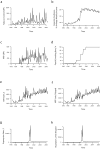Impact of tobacco control policies and mass media campaigns on monthly adult smoking prevalence
- PMID: 18556601
- PMCID: PMC2446442
- DOI: 10.2105/AJPH.2007.128991
Impact of tobacco control policies and mass media campaigns on monthly adult smoking prevalence
Abstract
Objectives: We sought to assess the impact of several tobacco control policies and televised antismoking advertising on adult smoking prevalence.
Methods: We used a population survey in which smoking prevalence was measured each month from 1995 through 2006. Time-series analysis assessed the effect on smoking prevalence of televised antismoking advertising (with gross audience rating points [GRPs] per month), cigarette costliness, monthly sales of nicotine replacement therapy (NRT) and bupropion, and smoke-free restaurant laws.
Results: Increases in cigarette costliness and exposure to tobacco control media campaigns significantly reduced smoking prevalence. We found a 0.3-percentage-point reduction in smoking prevalence by either exposing the population to televised antismoking ads an average of almost 4 times per month (390 GRPs) or by increasing the costliness of a pack of cigarettes by 0.03% of gross average weekly earnings. Monthly sales of NRT and bupropion, exposure to NRT advertising, and smoke-free restaurant laws had no detectable impact on smoking prevalence.
Conclusions: Increases in the real price of cigarettes and tobacco control mass media campaigns broadcast at sufficient exposure levels and at regular intervals are critical for reducing population smoking prevalence.
Figures


References
-
- Reducing Tobacco Use: A Report of the Surgeon General (Executive Summary). Atlanta, GA: Centers for Disease Control and Prevention; 2000.
-
- Hornik RC. Evaluation designs for public health communication programs. In: Hornik RC, ed. Public Health Communication: Evidence for Behavior Change. Mahwah, NJ: L Erlbaum Associates; 2002:385–405.
Publication types
MeSH terms
Substances
LinkOut - more resources
Full Text Sources
Medical

